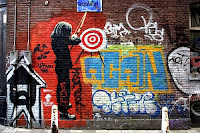 When you think of graffiti and street art, politics is probably one of the last things that comes to mind. There seems to be a complete disconnect between the two realms.
When you think of graffiti and street art, politics is probably one of the last things that comes to mind. There seems to be a complete disconnect between the two realms.Because of the illicit nature of graffiti, a can of paint and a brush are impractical while spatial considerations may make a pen or pencil ineffective. To accomodate the need for size, visibility, speed, and convenience, the ideal vehicle is the sray-can, which combines medium and applicator into one relatively small parcel that is easily concealed, transportable, easy to use; spray-paint may be applied to most surfaces. Different sized nozzles are used to achieve various effects, for example, a thin line as opposed to a wide band of paint. Where spray paint is not used or available, almost anything may serve as substitute: the aforementioned pen, pencil, paint and brush, as well as chisels, knives, felt-tip markers, blood, or even a finger on a dirty wall or window. Most media used for etching, sketching, painting, marking or writing can be adapted to such a purpose.
Because it is impossible to limit or regulate the resources that are available, graffiti as an art form and expressive medium is expandable, flexible, and difficult to control. The graffiti medium constitutes an open channel for its users to manipulate and mould to suit their needs. It represents a type of discontinuous communicative strategy through which people can engage in a visual dialogue which does not rely on face-to-face interaction or necessary knowledge of the writers' identities.
Individualized or popular graffiti include bathroom wall marking (latrinalia), signatures, proclamations of love, witty comments in response to advertisements, and any number of individual, political, or social commentary (folk epigraphy). In general these graffiti have no affiliation beyond the scope of the individual. It is close to impossible to locate their source.
Communities that produce graffiti (as opposed to the individual "scribbler") may target cryptic messages toward their own closed community, producing a seemingly confusing and unreadable product. The writers may not sign their real names; they instead employ the use of nicknames, codes, and symbols within stylized aesthetic systems. This type of graffiti is geared toward people who already understand the messages and may act to enhance group solidarity. Such graffiti can easily be elevated to the category of "art form" because the symbolic codes, generalized content, and aesthetic features of community-based graffiti usually outlast the duration of an individual's membership within the community. If a community's ideological focus is geared toward the larger society or the politics of the larger state, graffiti messages usually lack cryptic symbolism, make use of the national language, and retain a more straightforward aesthetic style.
An example of this cross-culturally prevalent genre of graffiti, political graffiti may combine with other artistic and expressive forms, such as poster and comic book production, mural painting, newspaper and pamphlet production, and political art exhibitions. The marks may represent the work of unrecognized or underground political groups, radical student movements, or simply dissatisfied individuals. Political graffiti may also arise from sudden emergency situations (e.g. riots) or in response to concurrent political legislation and party politics. Although concerned with state politics, the groups that produce this type of graffiti generally comprise some"subcultural" elements and may make wide use of symbols to further internally relevant quests for power and solidarity.







